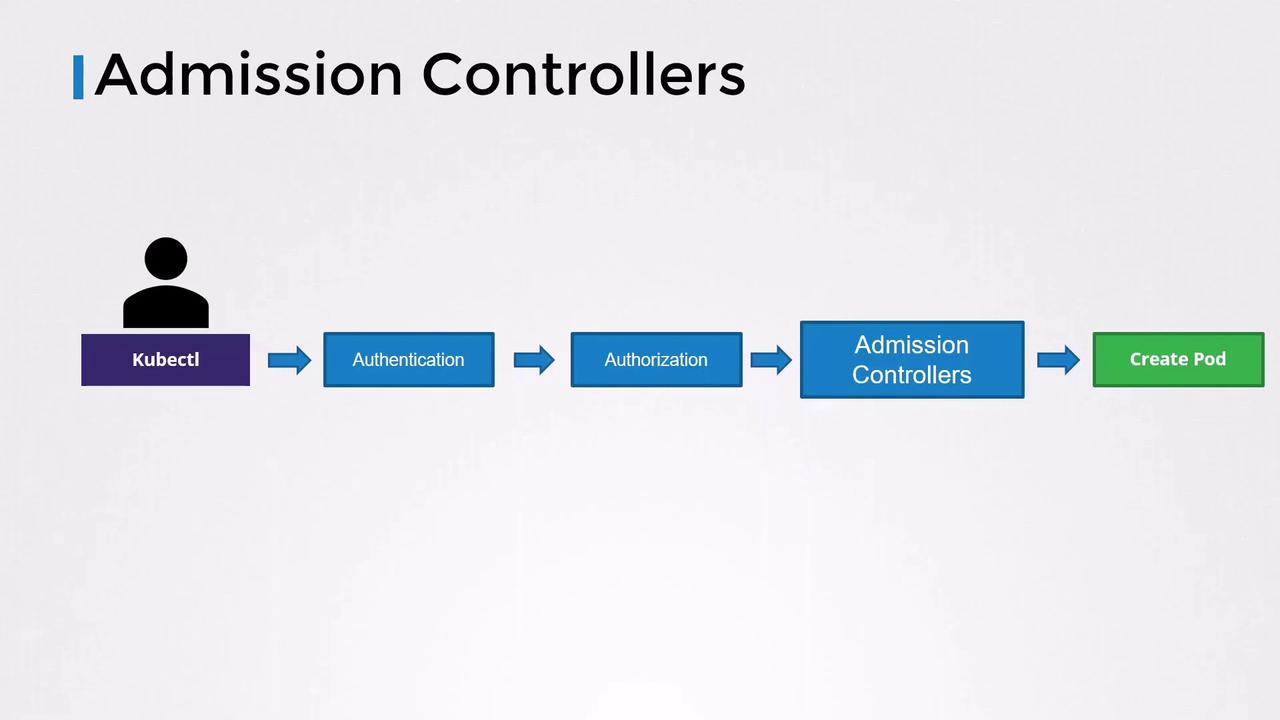Kubernetes and Cloud Native Security Associate (KCSA)
Platform Security
Admission Controllers
Admission Controllers are plugins that intercept requests to the Kubernetes API server after authentication and authorization but before they’re persisted in etcd. They enable cluster operators to enforce policies, mutate objects, or perform background actions automatically.
Kubernetes API Request Flow
When you run a kubectl command (e.g., creating a Pod), the request follows these steps:
- Authentication (AuthN): Verify user identity (usually via certificates in your kubeconfig).
- Authorization (AuthZ): Check if the requester has permission (via RBAC, ABAC, Node, Webhook).
- Admission Control (Admission Controllers): Validate or mutate objects.
- Persistence: Store the final object in etcd.

Authentication & Authorization Examples
kubeconfig Snippet
cat ~/.kube/config
apiVersion: v1
clusters:
- cluster:
certificate-authority-data: LS0t...
server: https://your-api-server
contexts:
- context:
cluster: your-cluster
user: your-user
name: your-context
current-context: your-context
users:
- name: your-user
user:
client-certificate-data: LS0t...
client-key-data: LS0t...
RBAC Role for Pod Operations
apiVersion: rbac.authorization.k8s.io/v1
kind: Role
metadata:
name: developer
rules:
- apiGroups: [""]
resources: ["pods"]
verbs: ["list", "get", "create", "update", "delete"]
You can further restrict to specific Pod names:
apiVersion: rbac.authorization.k8s.io/v1
kind: Role
metadata:
name: limited-developer
rules:
- apiGroups: [""]
resources: ["pods"]
verbs: ["create"]
resourceNames: ["blue", "orange"]
Why Admission Controllers?
RBAC governs who can perform what at the API surface. It cannot inspect or change the contents of an object. For example, you may want to enforce:
- Only use images from an internal registry
- Disallow
:latesttags - Prevent containers from running as root
- Inject security capabilities or sidecars
- Require specific labels or annotations
apiVersion: v1
kind: Pod
metadata:
name: web-pod
spec:
containers:
- name: ubuntu
image: ubuntu:latest
command: ["sleep", "3600"]
securityContext:
runAsUser: 0
capabilities:
add: ["MAC_ADMIN"]
Note
Admission Controllers can validate (reject bad requests) or mutate (inject defaults, sidecars) before persistence.
Built-in Admission Controllers
Kubernetes includes many Admission Controllers out of the box. Below is a summary of some common ones:
| Admission Controller | Behavior |
|---|---|
| AlwaysPullImages | Forces image pull for every Pod creation |
| DefaultStorageClass | Labels PVCs with a default StorageClass |
| EventRateLimit | Throttles API events to prevent overload |
| NamespaceExists | Rejects requests for non-existent namespaces |
Namespace Admission Controllers
NamespaceExists
By default, creating resources in a namespace that doesn’t exist yields:
kubectl run nginx --image=nginx --namespace=blue
# Error from server (NotFound): namespaces "blue" not found
NamespaceAutoProvision
NamespaceAutoProvision (disabled by default) automatically creates a namespace if it doesn’t exist when you submit a request.
Viewing Enabled Admission Controllers
kube-apiserver -h | grep enable-admission-plugins
On kubeadm-based clusters:
kubectl exec kube-apiserver-control-plane -n kube-system -- kube-apiserver -h | grep enable-admission-plugins
Enabling an Admission Controller
Update the API server’s startup arguments:
--enable-admission-plugins=NodeRestriction,NamespaceAutoProvision
Warning
Editing the kube-apiserver flags requires careful coordination. After changes, restart the API server or apply the updated control-plane manifest.
Example (systemd service):
ExecStart=/usr/local/bin/kube-apiserver \
--authorization-mode=Node,RBAC \
--enable-admission-plugins=NodeRestriction,NamespaceAutoProvision \
…other flags…
Example (kubeadm Pod manifest):
apiVersion: v1
kind: Pod
metadata:
name: kube-apiserver
namespace: kube-system
spec:
containers:
- name: kube-apiserver
image: k8s.gcr.io/kube-apiserver:v1.11.3
command:
- kube-apiserver
- --authorization-mode=Node,RBAC
- --enable-admission-plugins=NodeRestriction,NamespaceAutoProvision
…other flags…
Now, creating a Pod in a new namespace will auto-create it:
kubectl run nginx --image=nginx --namespace=blue
kubectl get namespaces
# NAME STATUS AGE
# blue Active 3m
# default Active 23m
# kube-public Active 24m
# kube-system Active 24m
NamespaceLifecycle Admission Controller
The NamespaceLifecycle plugin supersedes both NamespaceExists and NamespaceAutoProvision. It:
- Rejects requests to unknown namespaces
- Prevents deletion of critical system namespaces (
default,kube-system,kube-public)
Links and References
Watch Video
Watch video content
Practice Lab
Practice lab